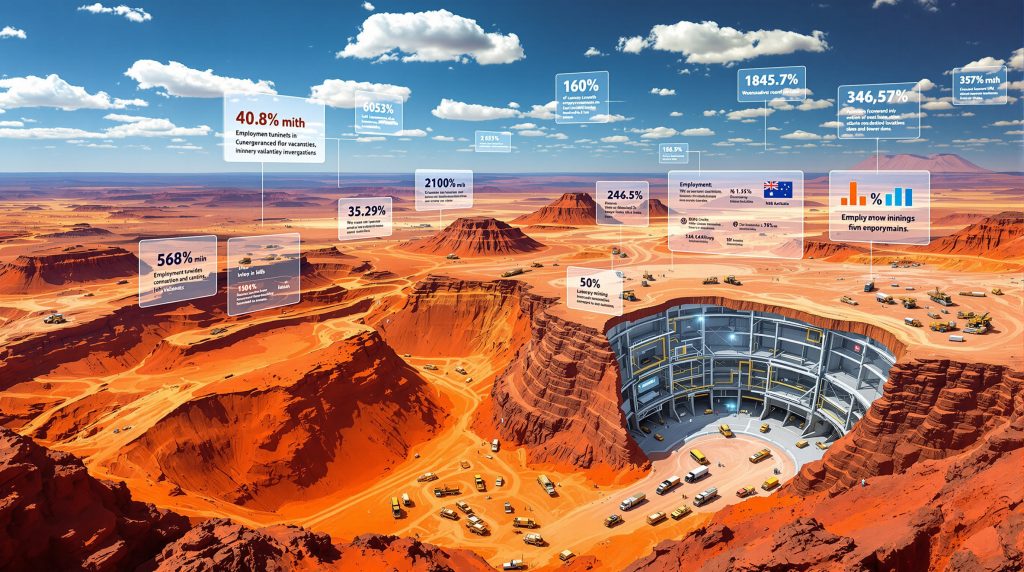Mining Jobs in Western Australia: Opportunities, Challenges, and Industry Outlook
What is the Current State of Mining Employment in Western Australia?
Western Australia's mining industry has reached unprecedented employment levels, with 2024 marking the eighth consecutive year of workforce growth. The state now accounts for 47% of Australia's total mining workforce, with a record 135,693 on-site full-time equivalent (FTE) positions.
This remarkable growth trajectory has positioned WA as the dominant force in Australia's mining employment landscape, with projections indicating it will drive approximately 40% of national resource workforce growth over the next five years. The WA resources contribution to the national economy continues to set records, highlighting the sector's importance.
Key Employment Statistics by Sector
| Mining Sector | Workers (FTE) | Year-on-Year Change |
|---|---|---|
| Iron Ore (Pilbara) | 65,359 | +4,500 |
| Gold (Goldfields/Mid-West) | 33,285 | +3,000 |
| Nickel | Declined | -3,200 |
The iron ore sector, predominantly centered in the Pilbara region, continues to be the largest employer with over 65,000 workers. Meanwhile, gold mining operations across the Goldfields and Mid-West regions have shown substantial growth, adding 3,000 positions over the past year.
In stark contrast, the nickel sector has experienced significant contraction, shedding over 3,200 jobs during 2024-25 due to challenging market conditions.
Regional Distribution of Mining Jobs
The Pilbara region maintains its position as the epicenter of WA's mining employment, primarily through expansive iron ore operations. The region's remote location has created unique workforce arrangements, with fly-in, fly-out (FIFO) employment models becoming standard practice for many operations.
The Goldfields region, traditionally known for its gold mining heritage, has experienced a renaissance with substantial employment growth driven by both established mines and new project developments.
Mid-West operations have also contributed significantly to the employment landscape, offering a mix of FIFO and residential opportunities across various commodities.
Why Are Mining Companies Struggling to Fill Positions Despite Record Employment?
The paradox of record employment figures alongside persistent talent shortages reveals deeper structural challenges within Western Australia's mining sector. Despite headline growth, employers face increasing difficulty filling critical technical roles.
Technical Skills Gap Analysis
- Underground mining operations face the most acute shortages, with specialized safety requirements creating barriers to quick workforce expansion
- Mine geology, engineering, and processing roles remain difficult to fill due to limited qualified candidates
- Safety-critical positions requiring specialized knowledge experience high vacancy rates
- Open-pit to underground transition skills are not easily transferable in the short-to-medium term
The technical nature of underground mining creates particularly challenging recruitment conditions. These operations require specialized safety knowledge and experience that cannot be rapidly developed, even when candidates have surface mining backgrounds.
As Steve Heather of MPI Recruitment explains, there is "acute demand being witnessed in every technical discipline across mine geology, engineering and processing, with the underground environment the biggest driver for the significant demand lift."
This skills gap is further complicated by the mining industry's cyclical nature, where workforce development often takes a backseat during downturns, creating talent deficits during subsequent growth periods.
How Are Commodity Price Fluctuations Affecting Mining Employment?
Western Australia's mining employment landscape reflects the volatile nature of global commodity markets, creating simultaneous growth and contraction across different sectors.
Recent Industry Restructuring
- BHP's Nickel West and IGO's Cosmos projects entered care and maintenance
- BHP reduced approximately 100 iron ore positions and 800 nickel jobs
- Rio Tinto cut around 500 Pilbara positions through outsourcing site services
- Smaller operators (Tier 3 and Tier 4) are experiencing the most significant challenges
- Larger companies (Tier 1) remain relatively insulated from downsizing pressures
The impact of these fluctuations varies significantly based on company size and operational diversity. Tier 1 mining companies have demonstrated greater resilience compared to smaller operators, which industry experts attribute to their financial buffers and ability to redeploy workers across diverse operations.
This two-speed adjustment creates additional market complications, as smaller companies face both economic pressures and talent competition from larger operators that can offer superior compensation and benefits.
What Strategies Are Being Used to Address Mining Talent Shortages?
Faced with persistent skills shortages, Western Australia's mining employers and industry bodies have implemented various strategies to attract and retain critical talent.
Recruitment and Retention Innovations
- Sign-on bonuses with six-month retention incentives to secure new hires
- Ongoing monthly payments to supplement base salaries in competitive markets
- Increased reliance on skilled migration to fill technical positions
- Targeted international recruitment from UK, Ireland, and African nations with strong mining traditions
Financial incentives have become increasingly common, particularly among companies competing for specialized technical talent. One company implemented a comprehensive approach featuring "a sign-on bonus, a six-month retention bonus, and then ongoing monthly payments" to maintain workforce stability.
While these strategies have helped address immediate needs, they represent short-term fixes rather than sustainable solutions to structural workforce challenges. Additionally, mining mental health support has become an increasingly important aspect of talent retention strategies.
Barriers to Workforce Development
- Prohibitive visa costs for smaller operators seeking international talent
- Training expense burdens without proportional government support
- Wage competition between large and small mining companies
- Inconsistent apprenticeship support across the industry
The visa system presents particular challenges for smaller mining operations. As Harriet Banda of Bantu Agency notes, "The cost is prohibitive and there is no scale. Whether your business makes $100m or $2m you still pay the 482 visa cost, which is unfair."
This financial burden disproportionately impacts smaller operators, limiting their ability to access international talent pools and further concentrating skilled workers within larger organizations.
Apprenticeship programs, which could help develop domestic talent, face their own set of challenges. Industry experts point to concerning patterns where "Apprentices are the first to be let go, yet they are the cheapest labour in the mining industry. Then when the next upturn happens, we don't have any tradespeople."
How Diverse is Western Australia's Mining Workforce?
While Western Australia's mining industry has made progress toward greater workforce diversity, significant gaps remain compared to broader Australian employment standards.
Gender Representation and Pay Equity
- Women comprise 24.8% of WA's mining workforce
- This figure lags behind the national workforce average of 48%
- Gender pay gaps exist across 95% of mining companies
- Industry experts debate the effectiveness of quota-based diversity approaches
The mining sector's gender imbalance reflects both historical patterns and ongoing women in mining challenges in creating inclusive workplaces. While progress has occurred, the significant gap between mining's female participation rate (24.8%) and the national workforce average (48%) indicates substantial room for improvement.
Some industry leaders have questioned whether numerical targets effectively address underlying issues. Dani Tamati argues that quota-driven approaches can be counterproductive, potentially "setting up many of these women to fail within their careers, because they are literally a tick-the-box exercise."
This perspective highlights the need for comprehensive approaches that combine recruitment initiatives with workplace culture improvements and career development pathways.
What is the Future Outlook for Mining Employment in Western Australia?
Western Australia's mining employment trajectory points toward continued growth, driven by project expansions and new developments across the state.
Projected Workforce Requirements
| Timeframe | New Workers Needed | Primary Drivers |
|---|---|---|
| By 2029 | 11,000+ | 48 proposed resource projects in WA |
| By 2033 | 56,000+ (nationally) | Expansion and replacement needs |
These projections highlight both the scale of opportunity and the workforce development challenge facing Western Australia's mining sector. Meeting these future needs will require coordinated efforts across industry, government, and educational institutions.
Priority Areas for Industry Development
- Educational pathways into mining careers
- Workforce diversity initiatives
- Digital skills development for automation and technology adoption
- Employee wellbeing programs to improve retention
- Government-industry partnerships for sustainable growth
Industry leaders have identified these focus areas as critical to building a sustainable mining workforce. Gavin Lind of AUSMASA emphasizes that educational pathways, diversity, digitalization, workforce retention and wellbeing represent key priorities for the sector's development.
However, concerns persist regarding government support levels. Steve Heather notes that "an awful lot of the heavy lifting is being left to the industry itself via its various associations and employer groups – but when you consider the huge contribution this industry makes to the Australian economy, why is the government not acting in its role of active industry partner?"
How Do Mining Jobs in WA Compare to Other Australian States?
Western Australia's dominance in mining employment creates a distinct labor market compared to other resource-rich states.
Comparative State Analysis
- WA accounts for 47% of Australia's mining workforce
- Expected to drive 40% of national resource workforce growth over next five years
- Offers generally higher wages than equivalent positions in eastern states
- Features more FIFO (fly-in, fly-out) arrangements due to remote operations
This concentration of mining employment gives Western Australia unique characteristics in terms of workforce mobility, compensation structures, and operational arrangements. The prevalence of FIFO work arrangements reflects both the remote location of many mining operations and the state's approach to resource development.
The higher wage levels in Western Australian mining jobs in Western Australia creates inter-state competition for talent, with workers often relocating to capitalize on superior compensation packages. Many candidates explore opportunities through BHP's Australian careers portal to find positions aligned with their skills and experience.
What Qualifications and Skills Are Most in Demand for WA Mining Jobs?
The evolving nature of Western Australia's mining operations has created specific skill requirements that shape employment opportunities across the sector.
High-Demand Qualifications
- Underground mining certifications
- Technical engineering degrees (mining, geological, mechanical)
- Safety management qualifications
- Digital technology competencies for automated systems
- Heavy machinery operation licenses and experience
Underground mining experience remains particularly valuable given the sector's growth and specific safety requirements. As operations become increasingly technical, engineering qualifications across various disciplines have also grown in importance.
The industry's digital transformation has created demand for workers with technology competencies who can operate and maintain increasingly automated systems. This shift represents both a challenge and an opportunity, creating new career pathways while potentially displacing traditional roles.
Many traditional manual roles are evolving, creating new opportunities for upskilled professionals and technical newcomers in the mining sector. The implementation of modern mine planning approaches has also created demand for professionals with specialized technical capabilities.
How Are Government Policies Affecting Mining Employment?
Industry leaders express concern that government support for mining workforce development lags behind other sectors despite the industry's substantial economic contribution.
Policy Gaps and Opportunities
- Building sector receives more direct training incentives than mining
- Industry associations carry disproportionate responsibility for workforce development
- Potential for expanded apprenticeship support to address long-term skills needs
- Migration policy adjustments could help address immediate technical shortages
The disparity in training support between mining and other sectors creates frustration among industry stakeholders. Dani Tamati notes that the building sector receives significantly more direct training incentives despite mining's larger economic contribution.
This perceived imbalance has led industry associations and employer groups to take on substantial workforce development responsibilities. While these initiatives have achieved important outcomes, they reflect a gap in coordinated government-industry partnerships.
Migration policies represent another area where government adjustments could support mining workforce development. Current visa structures and costs create barriers, particularly for smaller operators seeking to access international talent pools.
What Resources Are Available for Job Seekers in WA's Mining Industry?
Various organizations and initiatives support those looking to enter or advance in Western Australia's mining sector.
Key Support Resources
- Mining and Automotive Skills Alliance (AUSMASA) workforce planning
- Specialized mining recruitment agencies with technical knowledge
- Industry association training programs for upskilling
- Mining company graduate programs for new entrants
- Government-funded reskilling initiatives for workers transitioning from other industries
These resources provide valuable support for different segments of the mining workforce ecosystem. AUSMASA plays a central role in workforce planning and development, while specialized recruitment agencies help connect qualified candidates with appropriate opportunities.
For new entrants, mining company graduate programs offer structured pathways into the industry. These typically combine formal training with rotational work experiences to build both technical knowledge and practical capabilities. The annual WA mining conference also offers valuable networking opportunities for job seekers interested in the sector.
Workers transitioning from other sectors can access various reskilling initiatives, though industry leaders argue these could be expanded to better support mining's specific workforce needs. Many job seekers find success by exploring vacancies on platforms like SEEK's mining jobs portal.
FAQ About Mining Jobs in Western Australia
What is the average salary for mining jobs in Western Australia?
Mining salaries in WA vary widely by role, experience, and employer size. Entry-level positions typically start around $80,000-$100,000 annually, while specialized technical roles and management positions can command $150,000-$250,000+, often supplemented with various allowances and bonuses.
The sector generally offers higher compensation than equivalent roles in other industries, reflecting both the technical requirements and remote working conditions common in mining operations.
Are there entry-level mining jobs available in Western Australia?
Yes, the industry offers various entry points through apprenticeships, traineeships, and operator roles that provide on-the-job training. Large mining companies also run graduate programs for those with relevant qualifications but limited experience.
Entry-level pathways include equipment operation, maintenance support, and various site services roles. While competition for these positions can be intense, they provide valuable stepping stones to more specialized mining careers.
What is a typical FIFO roster in Western Australia mining?
FIFO (fly-in, fly-out) rosters vary by company and operation. Common patterns include 8 days on/6 days off, 14 days on/7 days off, or 2 weeks on/1 week off. Some remote operations may have longer rotations of 3-4 weeks on site followed by 1-2 weeks off.
These arrangements allow workers to live in metropolitan areas while accessing employment opportunities in remote mining regions. While FIFO work offers financial benefits, it can create challenges for work-life balance and family relationships.
How is technology changing mining jobs in Western Australia?
Automation, remote operations, and digital technologies are transforming traditional mining roles. While some manual positions are being replaced, new opportunities are emerging in technology management, remote operations centers, data analysis, and automated system maintenance.
This transition creates both challenges and opportunities for the mining workforce. Workers with digital competencies and adaptability will find expanding career pathways, while those in traditional roles may need upskilling to maintain their employability.
The industry's technological evolution also creates demand for specialized skills in areas like robotics, data science, and systems integration that weren't previously associated with mining operations.
Are You Ready to Invest in the Next Major Mineral Discovery?
Don't miss potential market-moving discoveries on the ASX. Discovery Alert's proprietary Discovery IQ model delivers instant notifications on significant mineral finds, helping you identify actionable opportunities before the broader market. Explore how historic discoveries have generated substantial returns by visiting Discovery Alert's dedicated discoveries page.




